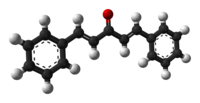Dibenzylideneacetone
 |
|
 |
|
 |
|
| Names | |
|---|---|
|
IUPAC name
(1E, 4E)-1,5-Diphenylpenta-1,4-dien-3-one
|
|
| Other names
Dibenzalacetone
|
|
| Identifiers | |
|
|
|
3D model (JSmol)
|
|
| ChemSpider | |
| ECHA InfoCard | 100.007.908 |
|
PubChem CID
|
|
| UNII |
|
|
|
|
|
| Properties | |
| C17H14O | |
| Molar mass | 234.29 g/mol |
| Appearance | Yellow solid |
| Melting point | *Aldrich 110-111 °C (trans, trans isomer)
|
| Boiling point | 130 °C (266 °F; 403 K) (cis, cis isomer) *Merck |
| insoluble | |
| Hazards | |
| Main hazards | Irritant |
|
Except where otherwise noted, data are given for materials in their standard state (at 25 °C [77 °F], 100 kPa).
|
|
|
|
|
| Infobox references | |
Dibenzylideneacetone or dibenzalacetone, often abbreviated dba, is an organic compound with the formula C17H14O. It is a pale-yellow solid insoluble in water, but soluble in ethanol. Dibenzylideneacetone is used as a component in sunscreens and as a ligand in organometallic chemistry.
The compound can be prepared in the laboratory through condensation of benzaldehyde and acetone with sodium hydroxide in a water/ethanol medium with the exclusive formation of the trans, trans isomer (melting point 110–111 °C).
This reaction is frequently encountered in organic chemistry education as a laboratory procedure. The conversion proceeds via the intermediacy of benzylideneacetone.
Prolonged exposure to sunlight converts the compound in a [2+2] cycloaddition to a mixture of four cyclobutane isomers.
Dibenzylideneacetone is a component of the catalyst tris(dibenzylideneacetone)dipalladium(0). It is a labile ligand that is easily displaced by triphenylphosphine, hence it serves a useful entry point into palladium(0) chemistry.
...
Wikipedia
